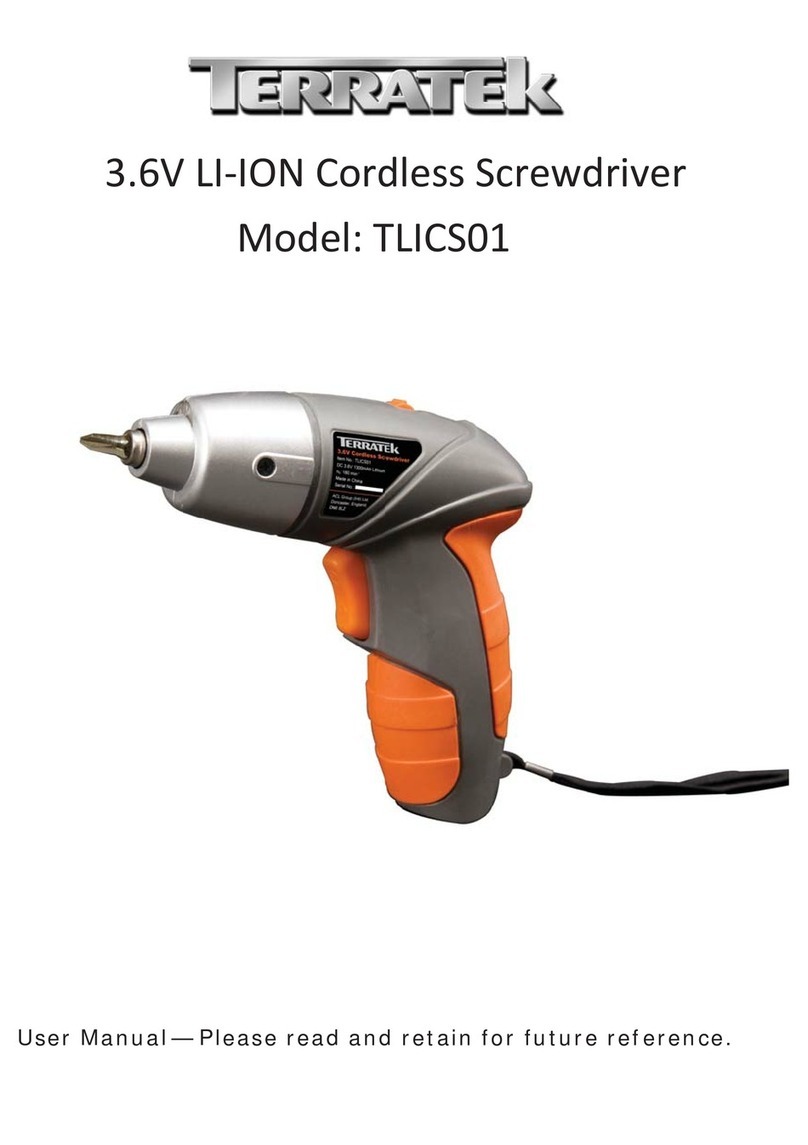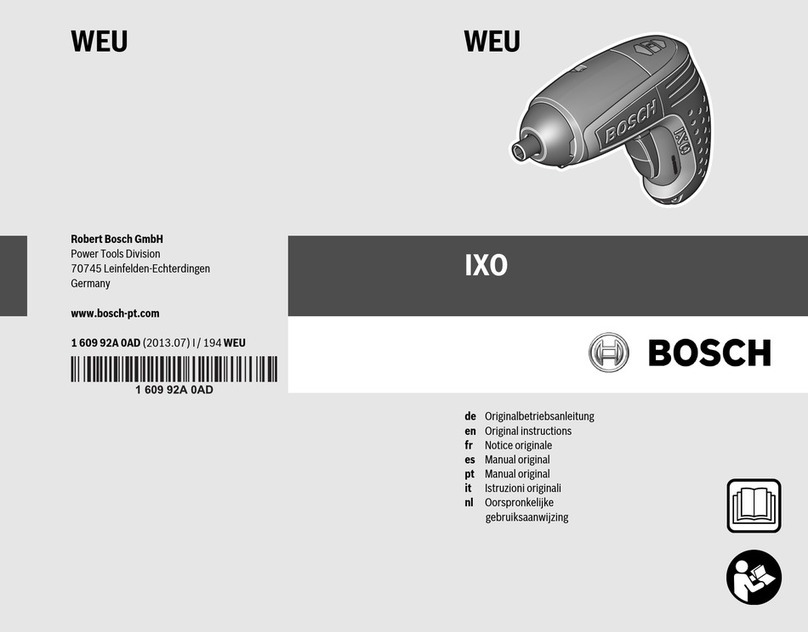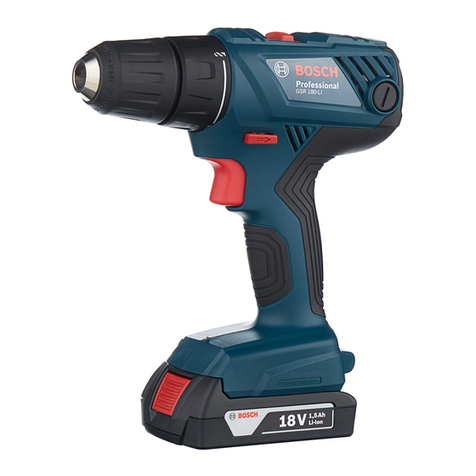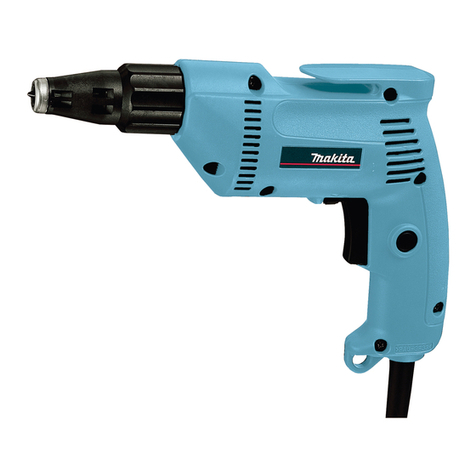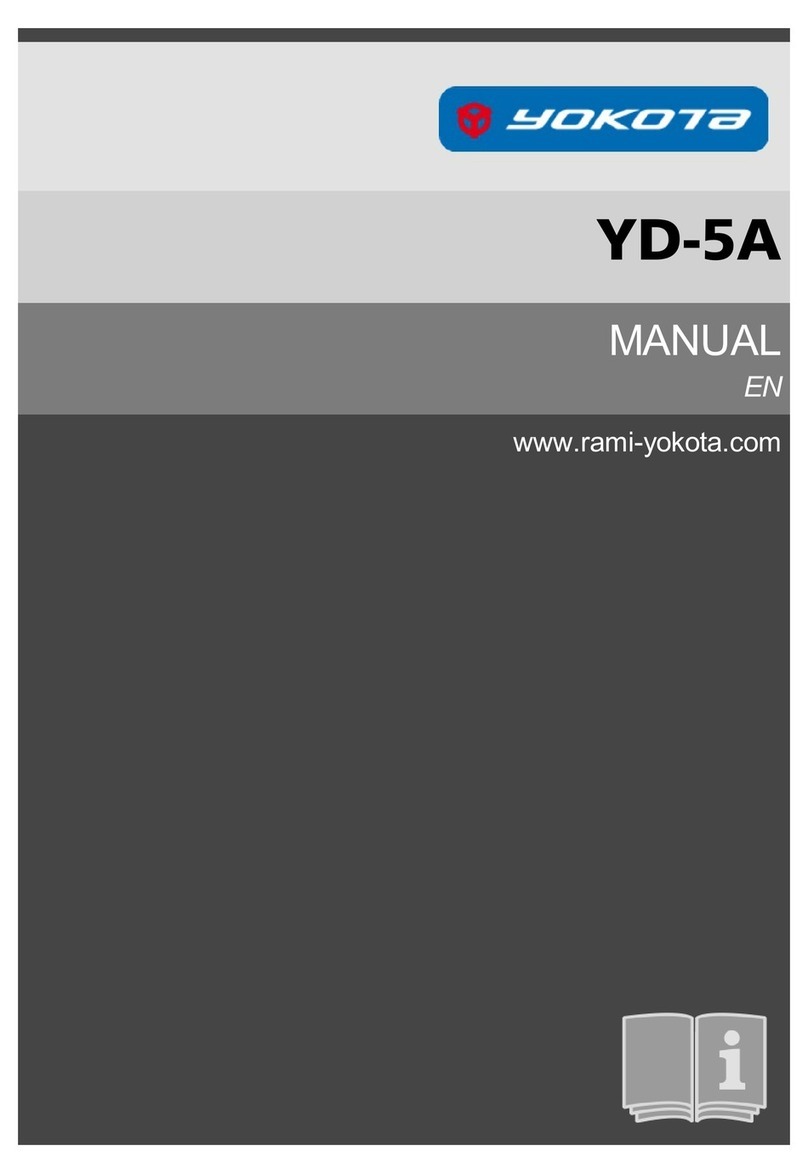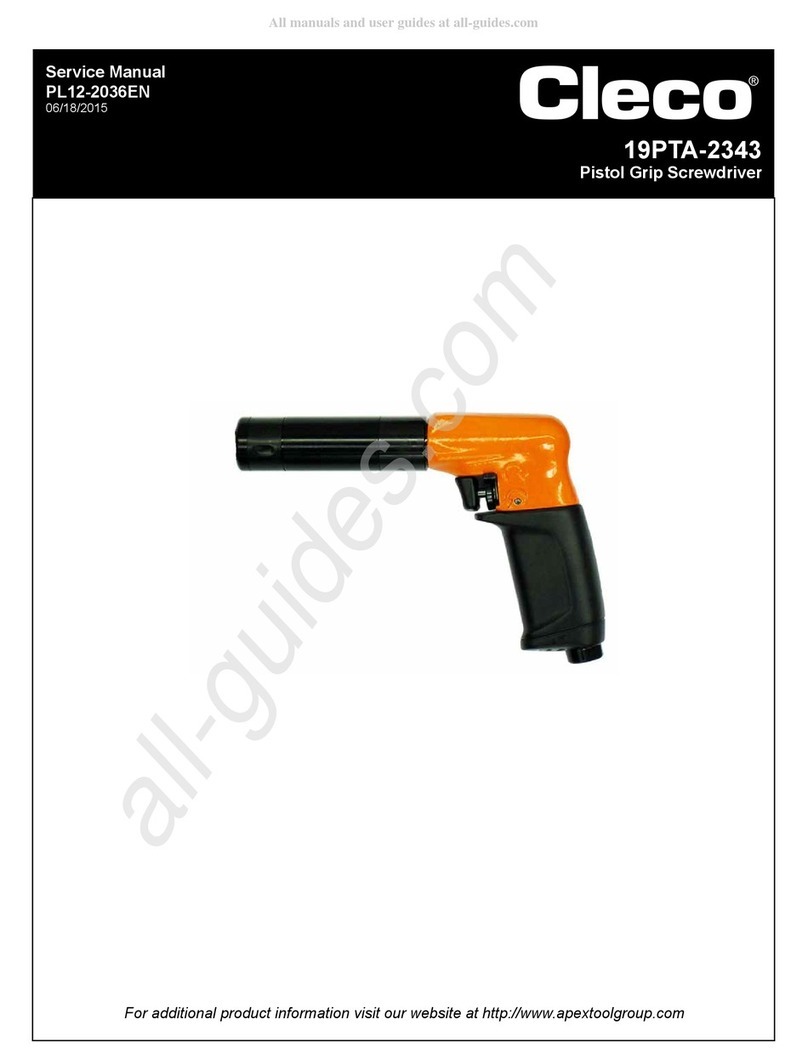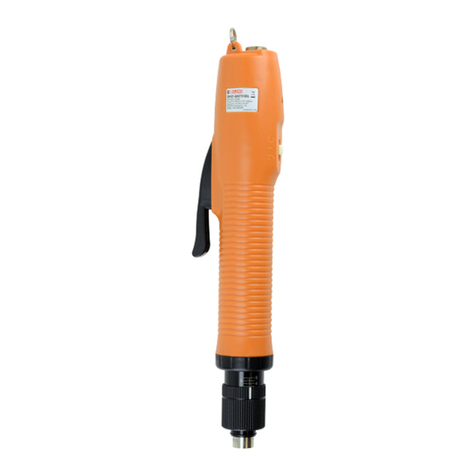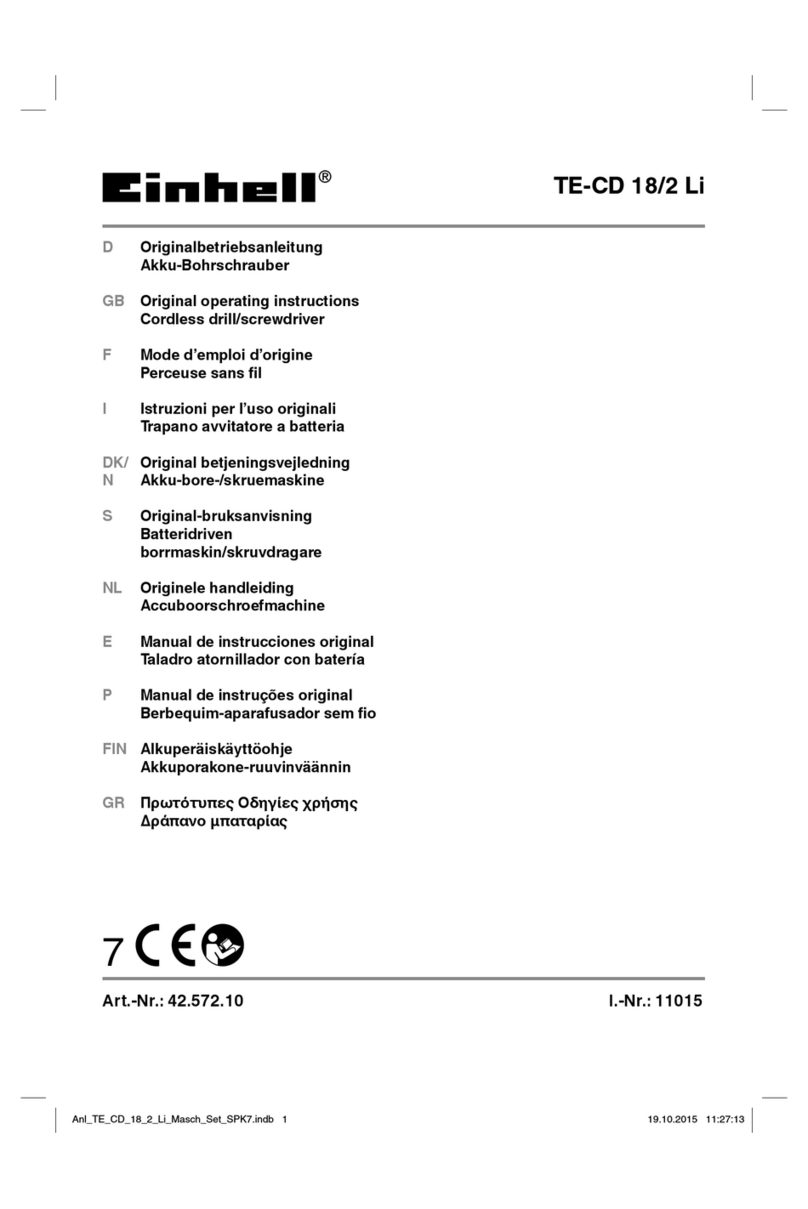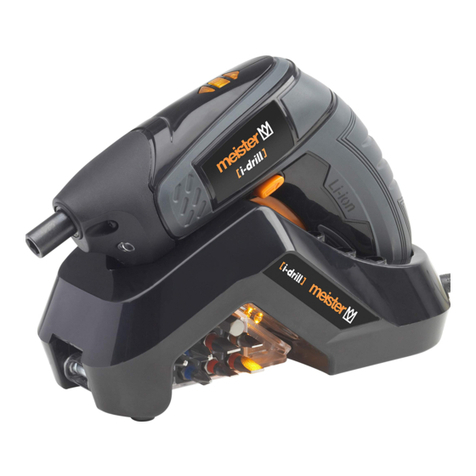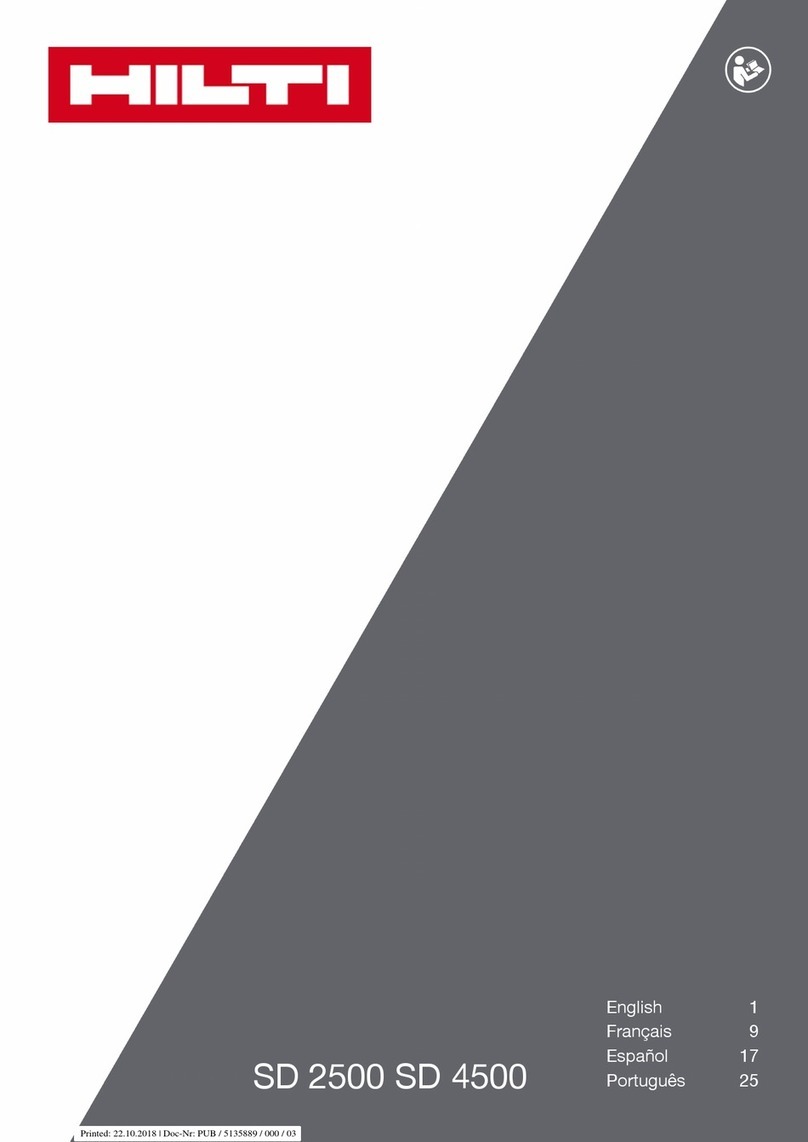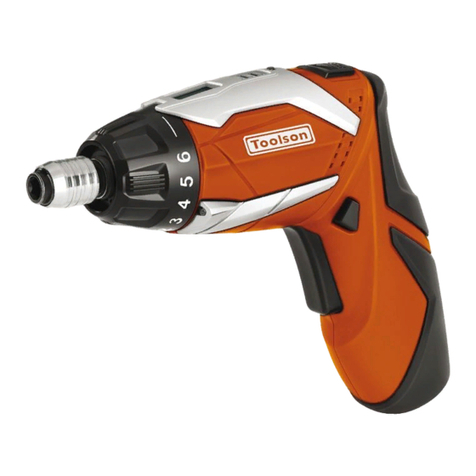Terratek FUT18V01-3 User manual

User Manual—Please read and retain for future reference
Contents
Parts List
Technical Information
Safety Instructions
Using your drill
Maintenance
Warranty
Part List
No
Description
No.
Description
1
Anti-Screw
18
Sun Gear
2
Chuck
19
1st Planet Gear
3
Clutch Cap
20
Motor Gear
4
Clutch Cap
21
Washer
5
Adjust Nut
22
Screw
6
Spring
23
Washer
7
Washer
24
Motor Plate
8
Steel Ball
25
Motor
9
Circlip
26
Screw
10
Steel Ball
27
Right Housing
11
Washer
28
Leaf Spring
12
Gear Box
29
Gauge Cover
13
Pin
30
F/R Lever
14
Output Shaft
31
Switch
15
Bush
32
PCB Board
16
Ring Gear
33
Left Housing
17
2nd Planet Gear
34
Battery

Exploded Assembly Diagram
NOTICE: Actual product may vary from pictures shown.

Overview:
Fig. 1
5
2
6
4
7
3
1
Fig. 2
Fig. 3
6
5
8

Specification: (Fig.1)
1. Chuck
2. Torque control ring
3. For. /Rev./Lockout
4. On/Off/Var. speed switch
5. Battery
6. Battery Clip
7. LED lamp
8. Charger
Technical Information
18 V Cordless Drill
Model: FUT18V01-3
Battery voltage: 18 V
Chuck capacity: 0.8 –10 mm
Max drilling capacity (steel) 8 mm
Max drilling capacity (wood) 20 mm
No load speed: 0 –650 /min
Torque settings 16 plus drill setting
Battery charger
Model: XR-6-220-260B
Input: 100-240V AC/ 50-60Hz 8.8W
Output: 22V DC/ 260 mA
Lithium Battery
Battery model: FUT18VBP-3
Capacity: 800 mAh
Noise and vibration levels
Sound pressure level 79.0 dB(A);
Sound power level 90.0 dB(A)
Uncertainty KPA: 3.0 dB(A) and KwA:3.0 dB(A)

Ear protection is required for the user.
Vibration levels
Drilling into metal: ahD = 1.339 m/s2, uncertainty KD= 1.5m/s2
The declared vibration total has been measured in accordance with a
standard test method and may be used for comparing one tool with another.
This total may also be used in a preliminary assessment of exposure.
Read this entire manual before using this product. Failure to
do so can result in serious injury. Save this manual for
future reference.
Copyright© 2017 by FUTURA Direct Ltd. All rights reserved. This manual or any
artwork contained herein must not be reproduced in any shape or form without the
express written consent of FUTURA Direct Ltd. Diagrams within this manual may not
be drawn proportionally. Due to continuing improvements, actual product may differ
slightly from the product described herein.
Read and Keep the Manual
Please read carefully all instructions within this manual. Failure to follow all safety
warnings can result in serious personal injury. The term “Power Tool” in all of the
following warnings refers to your mains operated (corded) or battery operated (cordless)
power tool
Important SAFETY Information
This symbol is to warn you of potential personal injury hazards. Please
read carefully the notes alongside this warning to avoid possible injury
or death.
General Safety Rules
WARNING! Read all instructions. Failure to follow all instructions listed below
may result in electric shock, fire and/or serious injury. The term “power tool” in
all of the warnings listed refers to corded or cordless power tools.
Work area safety
Keep work area clean and well lit. Cluttered or dark areas invite accidents.
Do not operate power tools in explosive atmospheres, such as in the presence of
flammable liquids, gases or dust. Power tools create sparks which may ignite the dust

or fumes.
Keep children and bystanders away while operating a power tool. Distractions can cause
you to lose control.
Electrical safety
Before use, ensure that the power outlet you are using matches the plug on your power
tool and that the voltage of the outlet matches that of your power tool.
Only use grounded extension cords with power tools fitted with proper plugs and if using
outdoors ensure any extension cord is suitable for outdoor use.
Always try to avoid body contact with grounded surfaces, such as radiators, cooking
ranges and any other fixed appliance with metal surfaces.
Do not expose your power tool to wet or damp conditions and NEVER use in rain.
Check regularly the power cord of your machine and any extension cord that you are
using for damage.
Do not carry or pull the machine with the power cord.
Ensure the cord is clear from hot surfaces, oil or sharp objects.
Personal safety
Never use your power tool whilst under the influence of alcohol, drugs or medication.
Tiredness can often cause accidents, stay alert.
Never use your power tool without the correct guards in place.
Always use ANSI approved eye protection and dust mask. Non slip safety shoes and
hearing protectors should be worn at all times when using your power tool.
Ensure any dust collecting device supplied with your power tool is connected correctly
before use.
Ensure all loose clothing, long hair or jewelry is kept clear of the power tool.
Before plugging your power tool into the power outlet ensure the power tool is in the
OFF position.
Check that wrenches or adjusting keys have been removed. Any wrench or key left
attached to a moving part can result in injury.
Power tool use and care.
Keep your power tool clean and well serviced at all times.
Never adjust or service any power tool before disconnecting from the mains electricity
supply.
Always use the correct tool for the job.
Never force the tool to work harder than it is designed to do.
Never use your power tool with broken parts such as switches, guide fences or leg
stands.

ALWAYS keep your power tools away from children.
Keep cutting tools sharp to ensure less stress on the motor.
Only have your power tool serviced by a qualified repair agent using manufacturers
recommended parts.
WARNING: For your own safety read Instruction Manual before operating your tool.
A) Wear eye protection.
B) Keep hands away from drill bit.
C) Do not operate without guards in place.
D) Do not perform any operation freehand.
E) Never grab chuck while it is turning.
F) Turn off tool and wait for tool to stop before moving workpiece or changing settings.
G) Remove battery before changing drill bit or servicing.
Safety Instructions
Read this owner's manual completely and make sure you understand all of its
safety guidelines.
1) Do not overload the appliance. Use the correct tool for your work. You will be able to
work better and more safely within the given performance boundaries.
2) Do not use an electric tool with a defective switch. An electric tool that cannot be
switched on or off is dangerous and must be repaired.
3) Pull the plug out of the socket and/or remove the battery before making any
adjustments to the appliance, changing accessories or put the appliance down. This
safety measure prevents starting the electric tool unintentionally.
4) Keep unused electric tools out of the reach of children. Do not allow people who are
not familiar with the appliance or who have not read these instructions to use the
appliance. Electric tools are dangerous if they are used by inexperienced people.
5) Clean your electric tool carefully. Check whether moving parts are functioning
properly and not jamming, whether parts are broken or damaged enough that the
functioning of this electric tool is affected. Have damaged parts repaired before using
the appliance. Many accidents are caused by badly maintained electric tools.
6) Keep your cutting tools sharp and clean. Carefully maintained cutting tools with sharp
cutting edges will jam less and are easier to control.
7) Make sure to use electric tools, accessories, attachments, etc. in accordance with
these instructions. Take the conditions in your work area and the job in hand into
account.
Using electric tools for any purpose other than the one for which they are intended can
lead to dangerous situations.
8) Ensure that the tool is switched off before you insert the battery. Inserting a battery
into an electric tool that is switched on can cause accidents.
9) Only charge the batteries in chargers that are recommended by the manufacturer. A
charger that is designed for a certain type of battery may pose a fire risk if it is used
with other types of battery.
10) Use only the correct batteries in the electric tools. The use of other batteries may
result in injuries and a fire risk.

11) Keep unused batteries away from paper clips, coins, keys, nails, screws and other
metallic objects that could cause a short circuit between the contacts. A short circuit
between the battery contacts may cause burns or a fire.
12) In case of incorrect use, fluid may escape from the battery. Avoid contact with it. If
you touch it by accident, rinse the affected area with water. If you get the fluid in your
eyes, also seek medical advice. Leaking battery fluid can cause skin irritation or burns.
Safety Warnings for Battery Pack
a) Do not dismantle, open or shred cells or battery pack.
b) Do not short-circuit a battery pack. Do not store battery packs haphazardly in a box
or drawer where they may short-circuit each other or be short-circuited by conductive
materials. When battery pack is not in use, keep it away from other metal objects, like
paper clips, coins, keys, nails, screws or other small metal objects that can make a
connection from one terminal to another. Shorting the battery terminals together may
cause burns or a fire.
c) Do not expose battery pack to heat or fire. Avoid storage in direct sunlight.
d) Do not subject battery pack to mechanical shock.
e) In the event of battery leaking, do not allow the liquid to come into contact with the
skin or eyes. If contact has been made, wash the affected area with copious amounts of
water and seek medical advice.
f) Seek medical advice immediately if a cell or battery pack has been swallowed.
g) Keep battery pack clean and dry.
h) Wipe the battery pack terminals with a clean dry cloth if they become dirty.
i) Battery pack needs to be charged before use. Always refer to this instruction and use
the correct charging procedure.
j) Do not maintain battery pack on charge when not in use.
k) After extended periods of storage, it may be necessary to charge and discharge the
battery pack several times to obtain maximum performance.
l) Battery pack gives its best performance when it is operated at normal room
temperature (20 °C ± 5 °C).
m) When disposing of battery packs, keep battery packs of different electrochemical
systems separate from each other.
n) Recharge only with the charger specified. Do not use any charger other than that
specifically provided for use with the equipment. A charger that is suitable for one type
of battery pack may create a risk of fire when used with another battery pack.
o) Do not use any battery pack which is not designed for use with the equipment.
p) Keep battery pack out of the reach of children.
q) Retain the original product literature for future reference.
r) Remove the battery from the equipment when not in use.
s) Dispose of properly.
Additional Safety Instructions for Your Battery Charger
1. Do not charge a leaking battery.
2. Do not use chargers for works other than those for which they are designed.
3. Before charging, ensure your charger is matching the local AC supply.
4. For indoor use, or do not expose to rain.
5. The charging device must be protected from moisture.
6. Do not short out the contacts of battery or charger.
7. Respect the polarity “+/-“ when charging.

8. Do not open the unit and keep out of the reach of children.
9. Do not charge the batteries of other manufacturers or ill-suited models.
10. Ensure that the connection between the battery charger and battery is correctly
positioned and is not obstructed by foreign bodies.
11. Keep battery charger’s slots are free of foreign objects and protect against dirt and
humidity. Store in a dry and frost-free place.
12. When charging batteries, ensure that the battery charger is in a well-ventilated area
and away from inflammable materials. Batteries can get hot during charging. Do not
overcharge any batteries. Ensure that batteries and chargers are not left unsupervised
during charging.
13. Do not recharge non-rechargeable batteries, as they can overheat and break.
14. Longer life and better performance can be obtained if the battery pack is charged
when the air temperature is between 18oC and 24oC. Do not charge the battery pack in
air temperatures below 4.5oC, or above 40.5oC. This is important as it can prevent
serious damage to the battery pack.
15. Charge only battery pack of the same model provided.
Power Extension Cords
When using any extension cord the machine will suffer a power reduction due to the
drop in voltage caused by the length of the cord. This can be partially offset by selecting
extension cords with lower gauge wire.
Check all extension cords for damage before use.
Avoid sharp objects.
Do not position the cord where it could be subject to traffic passing over it.
Symbols
IMPORTANT: Some of the following symbols may be used on your tool.
V…………………………volts
A…………………………amperes
Hz……………………….hertz
~…………………….….alternating current
…/m……………….....revolutions per minute
回.....................class II construction (double insulated)
Kg………………………..kilograms
n0………………………..No load speed
CE ………………….……Conforms to European safety standards
DC ………………..…….Direct Current
Unpacking
Carefully remove the product and any accessories from the box. Make sure that all items
listed in the packing list are included.
Packing List
A) Drill
B) Battery

C) Charger
D) Manual
Battery use and care
A battery operated tool with integral batteries or a separate battery pack must
be recharged only with the specified charger for the battery.
A charger that may be suitable for one type of battery may create a risk of fire when
used with another battery.
Use battery operated tool only with specifically designed battery pack.
Use of any other batteries may create a risk of fire.
NEVER place hands or other body parts near the drill bit or chuck during operation.
Hold the drill by its handle only. Because the cordless driver drill operates by battery
power, be aware of the fact that it can begin to operate at any time.
When battery pack is not in use, keep it away from other metal objects like
paper clips, coins, keys, nails, screws, or other small metal objects that can
make a connection from one terminal to another. Shorting the battery terminals
together may cause burns or a fire.
Charging the Battery Pack (Fig. 2 and 3)
1. Before their first use, the battery (5) must be loaded.
2. Only use the provided charging unit (8) to charge the battery set.
3. Only charge the battery set when the ambient temperature is within 10° - 40° C.
4. Plug the adaptor (8) to a 230V alternating voltage source.
5. The battery (5) should under no circumstances be disassembled.
6. To remove the battery set, press the attachment clip (6) on the top side of the
battery set and extract the battery (5).
7. Connect the plug of the charger to the loading-socket of the battery-set.
8. Red and green LED will light once the battery has been connected to the charger and
the charging procedure will proceed.
9. The battery set is completely loaded and ready for use once the green LED is lit and
the red LED is OFF.
Using your drill
Keyless chuck
The keyless drill chuck (1) allows the clamping of drill bits or other tools without the use
of a drill chuck key.
1. Before inserting a drill bit or other tool, the rotation direction switch (3) must be
switched to its central position.
2. Rotate the front section of the drill chuck (1) to the right to open the jaws until the
tool can be inserted.
3. Insert the drill bit or the tool as far as it will go into the drill chuck.

4. To close the drill chuck, rotate the front section to the left to close the jaws.
5. Ensure that the drill bit or tool is seated correctly and centrally as you close the drill
chuck.
Working LED lamp
Pushing the On/Off Switch button (4) will turn on the working LED lamp (7).
Leaving the On/Off Switch button (4) will switch off the working LED lamp (7).
Variable Speed Controlled Trigger Switch
Your tool is equipped with a variable speed trigger switch. The tool speed can be
controlled from the minimum to the maximum nameplate RPM by the pressure you
apply to the trigger.
Apply more pressure to increase the speed and release pressure to decrease speed.
Forward/Reversing Lever & Trigger Lock
Your tool is equipped with a forward/ reversing lever and trigger lock located above the
trigger. This lever was designed for changing rotation of the chuck, and for locking the
trigger in an “OFF” position to help prevent accidental starts and accidental battery
discharge. For forward rotation, (with chuck pointed away from you) move the lever to
the far left. For reverse rotation move the lever to the far right.
To activate trigger lock move lever to the center “off” position.
CAUTION:
Ensure the drill has come to a complete stop before changing direction.
Mounting and Dismounting the Bit
Mounting the bit
Loosen the sleeve by turning it toward the left (in the counterclockwise direction as
viewed from the front) to open the clip on the keyless chuck. After inserting a driver bit,
etc., into the keyless drill chuck, tighten the sleeve by turning it toward the right (in the
clockwise direction as viewed from the front).
NOTE: If the sleeve becomes loose during operation, tighten it further.
The tightening force becomes stronger when the sleeve is tightened.
Dismounting the Bit
Loosen the sleeve by turning it toward the left (in the counterclockwise direction as
viewed from the front), and then take out the bit.
Drilling
Place the bit on the work surface and apply firm pressure before starting. Too much
pressure will slow the bit and reduce drilling efficiency. Too little pressure will cause the
bit to slide over the work area and dull the point of the bit. If the tool begins to stall,
reduce pressure slightly to allow the bit to regain speed. If the bit binds, reverse the
motor to free the bit from the workpiece.
Drilling in wood
• Make an indentation at the desired hole location using a centre punch or nail.
• Place a piece of waste wood under the workpiece or drill the hole from both sides to

avoid damaging the workpiece at hole breakthrough.
• The maximum hole diameter can only be achieved using Forstner bits.
Driving wood screws
• Where possible use crosshead wood screws.
• Ensure that you use the correctly sized screwdriver bit.
• Drill an appropriately sized pilot hole before driving in the screw. Driving without pilot
drilling increases the risk that the wood may split or that the screw may break.
Drilling in metal
• Make an indentation at the desired hole location using a centre punch.
• Always secure the workpiece using an appropriate clamping device. Lay a piece of
wood under thin sheets of metal to prevent deformation.
• Use only well sharpened HSS drill bits when drilling metal. If a large hole diameter is
required, drill a pilot hole using a smaller bit first.
• When drilling metal, consult the following table to determine the appropriate lubricant.
Torque Adjustment
By turning the adjustment ring (Fig.1) the required torque can be adjusted. The arrow
aligns with the adjusted state.
Maintenance
WARNING: To reduce the risk of injury, always unplug the charger and remove the
battery pack from the charger or tool before performing any maintenance. Never
disassemble the tool, battery pack or charger.
Disposal of the exhausted battery
WARNING: Do not dispose of the exhausted battery. The battery must explode if it is
incinerated. The product that you have purchased contains a rechargeable battery. The
battery is recyclable. At the end of its useful life, under various state and local laws, it
may be illegal to dispose of this battery into the municipal waste stream. Check with
your local solid waste officials for details in your area for recycling options or proper
disposal.

Disposal
Power tools, accessories and packaging should be sorted for environmentally-friendly
recycling.
Only for EC countries:
Do not dispose of power tools into household waste!
According to the European Directive 2002/96/EC on waste electrical and
electronic equipment and its incorporation into national right, products that are
no longer suitable for use must be separately collected and sent for recovery in
an environmentally-friendly manner.
Declaration of Conformity
The declaration is to certify that it conforms to CE, EMC, MD and RoHS
directives:
EN55014-1:2006+A1 + A2
EN55014-2:2015
All provisions of Annex 1 of Council Directive 2014/30/EU –EMC directive
EN60745-1: 2009 + A11
EN60745-2-1: 2010
EN60745-2-2: 2010
All provisions of Annex 1 of Council Directive 2006/42/EC –the Machinery
Directive
RoHs 2011/65/EU
Mr. Paul Kaye, UK QA Manager

Please read the following carefully
FUTURA Direct Ltd. and/or its distributor have provided the parts list and assembly
diagram as a reference tool only. Neither FUTURA Direct Ltd. or its distributor makes
any representation or warranty of any kind to the buyer that he or she is qualified to do
any repairs or replace any parts of this product. FUTURA Direct Ltd. and its distributor
expressly state that all repairs or parts replacement should be done by certified or
licensed technicians. The buyer assumes all risk and liability arising out of his or her
repairs or parts replacement to the original product.
24 Months Limited Warranty
If within 24 months from the date of purchase you experience any problems with your
product, please return the product to its distributor/dealer for repair or replacement.
This warranty DOES NOT COVER normal wear, or any damage as a result of accidents,
misuse, abuse or negligence.
Table of contents
Other Terratek Power Screwdriver manuals


